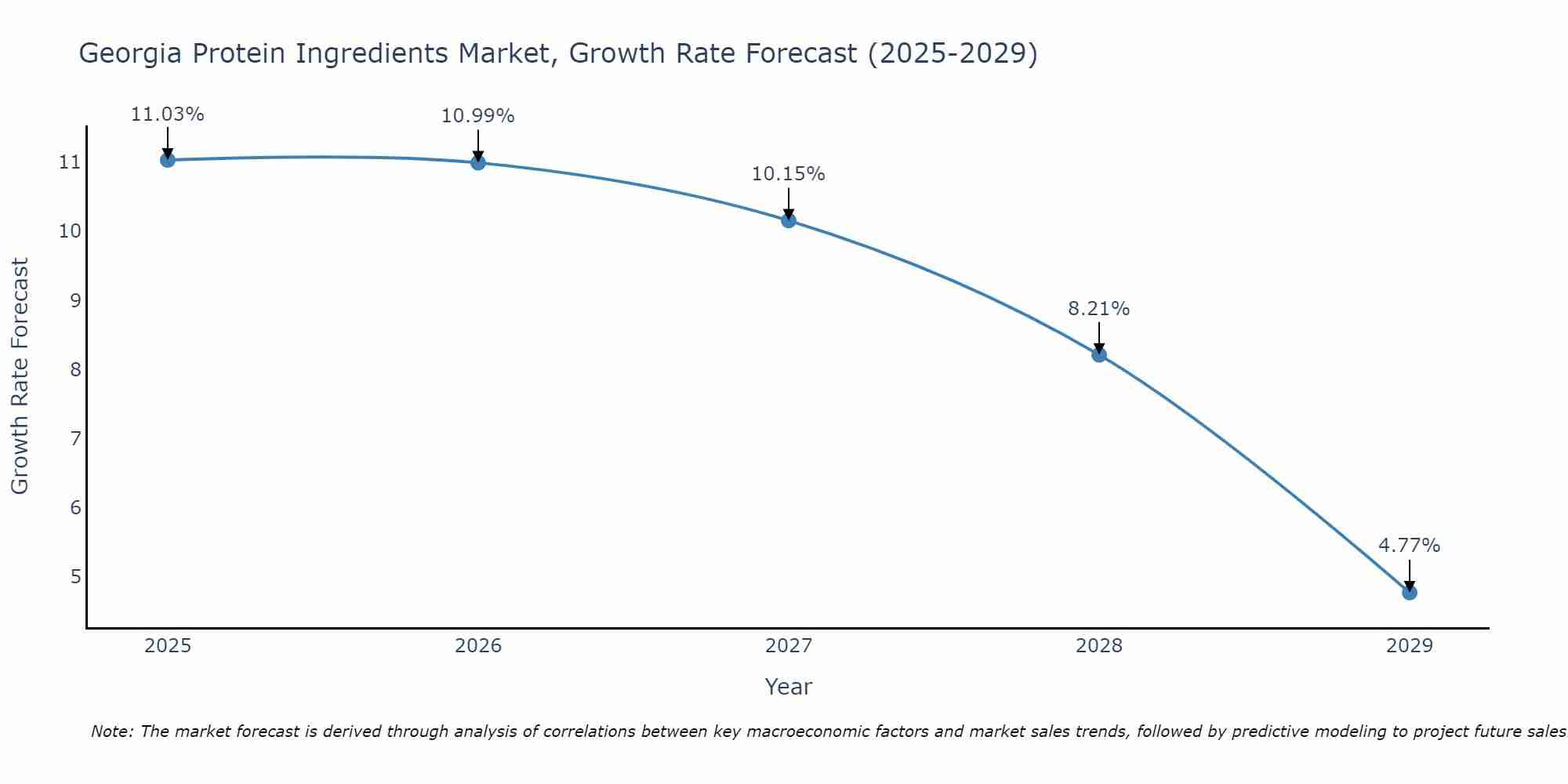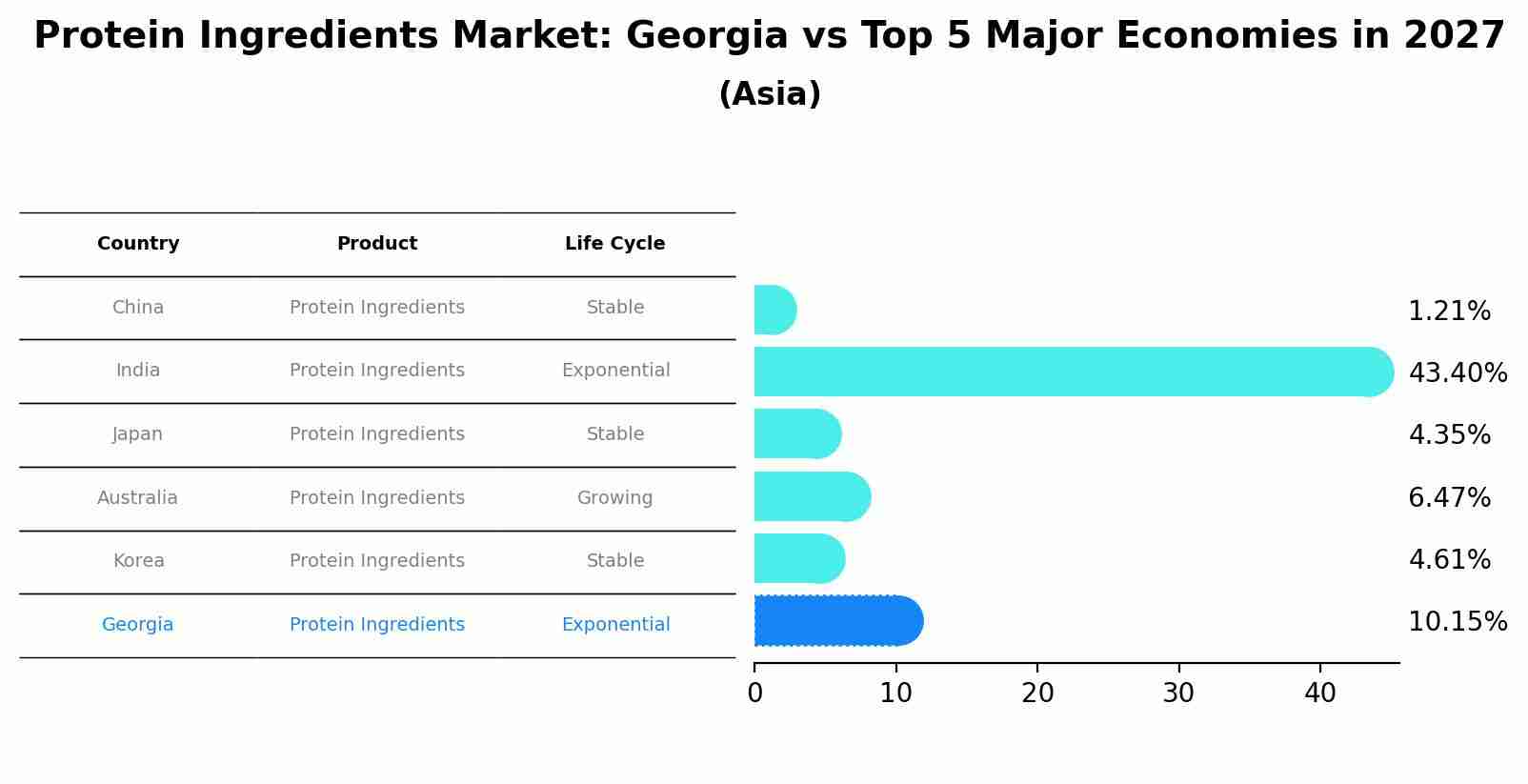Georgia Protein Ingredients Market (2025-2031) Outlook | Revenue, Value, Forecast, Size, Industry, Companies, Analysis, Trends, Share & Growth
| Product Code: ETC127971 | Publication Date: Jun 2021 | Updated Date: Apr 2025 | Product Type: Report | |
| Publisher: 6Wresearch | No. of Pages: 70 | No. of Figures: 35 | No. of Tables: 5 | |
Georgia Protein Ingredients Market Size Growth Rate
The Georgia Protein Ingredients Market could see a tapering of growth rates over 2025 to 2029. Although the growth rate starts strong at 11.03% in 2025, it steadily loses momentum, ending at 4.77% by 2029.

Protein Ingredients Market: Georgia vs Top 5 Major Economies in 2027 (Asia)
The Protein Ingredients market in Georgia is projected to grow at a high growth rate of 10.15% by 2027, highlighting the country's increasing focus on advanced technologies within the Asia region, where China holds the dominant position, followed closely by India, Japan, Australia and South Korea, shaping overall regional demand.

Georgia Protein Ingredients Market Overview
The Georgia protein ingredients market is experiencing significant growth propelled by the demand for protein-rich ingredients in food and beverage products to meet consumer preferences for health and wellness. Protein ingredients include sources such as whey, soy, pea, and milk proteins used as functional additives and nutritional fortifiers in various food and beverage applications. With increasing interest in plant-based diets, sports nutrition, and clean label products, manufacturers in Georgia are incorporating protein ingredients into formulations for snacks, beverages, and meal replacements, driving market expansion and diversification in the region.
Drivers of the market
The protein ingredients market in Georgia is experiencing robust growth driven by several key factors. One of the primary drivers is the increasing consumer demand for protein-rich foods and dietary supplements to support various health and wellness goals such as muscle building, weight management, and overall nutrition. With the rise of plant-based diets, sports nutrition, and functional foods, there is a growing need for protein ingredients derived from diverse sources such as dairy, soy, pea, and whey, which offer essential amino acids and bioactive compounds essential for human health. Additionally, the expansion of the food and beverage industry and the growing trend of product fortification are driving market growth by creating opportunities for protein ingredient manufacturers to innovate and develop formulations tailored to specific nutritional requirements and sensory preferences. Moreover, the adoption of advanced processing technologies such as membrane filtration, enzymatic hydrolysis, and protein isolation is further fueling market expansion by enabling the production of high-quality protein ingredients with improved functionality, solubility, and bioavailability in Georgia.
Challenges of the market
The Georgia protein ingredients market faces challenges related to sourcing sustainability, market differentiation, and consumer demand. Protein ingredients, including animal-based proteins, plant-based proteins, and alternative proteins, serve as essential nutrients in food and beverage products, such as dairy alternatives, meat substitutes, and sports nutrition supplements. However, ensuring sourcing sustainability and ethical practices in protein production, such as animal welfare, environmental impact, and supply chain transparency, poses challenges for protein ingredient suppliers and manufacturers in terms of raw material procurement, processing methods, and certification requirements. Moreover, addressing market differentiation and positioning strategies for protein ingredients, such as functional benefits, nutritional profiles, and sensory attributes, adds complexity to product development, marketing strategies, and brand positioning efforts. Additionally, competing in a crowded market landscape, with the presence of both established protein ingredient suppliers and new entrants, demands differentiation, innovation, and customer engagement. Furthermore, adapting to changing consumer preferences and market trends, such as demand for clean label products, plant-based diets, and sustainable sourcing, presents challenges in terms of product innovation, marketing strategies, and supply chain optimization. Overcoming these challenges necessitates collaboration between protein ingredients suppliers, food manufacturers, and regulatory authorities to develop and supply high-quality protein ingredient solutions that meet nutritional requirements, sustainability goals, and consumer expectations in the Georgia protein ingredients market.
Government Policy of the market
In the protein ingredients market, Georgia policies prioritize food safety, quality, and innovation in protein-rich food products and supplements. Regulatory frameworks address standards for ingredient purity, labeling requirements, and nutritional claims to ensure the safety and integrity of protein ingredient products. Additionally, support for research and development initiatives, technology transfer, and industry partnerships contributes to the growth and competitiveness of Georgia protein ingredients industry. By fostering collaboration between ingredient suppliers, food producers, and regulatory agencies, Georgia aims to enhance its position as a supplier of high-quality protein ingredients and contribute to consumer health, nutrition, and wellness.
Key Highlights of the Report:
- Georgia Protein Ingredients Market Outlook
- Market Size of Georgia Protein Ingredients Market, 2024
- Forecast of Georgia Protein Ingredients Market, 2031
- Historical Data and Forecast of Georgia Protein Ingredients Revenues & Volume for the Period 2021-2031
- Georgia Protein Ingredients Market Trend Evolution
- Georgia Protein Ingredients Market Drivers and Challenges
- Georgia Protein Ingredients Price Trends
- Georgia Protein Ingredients Porter's Five Forces
- Georgia Protein Ingredients Industry Life Cycle
- Historical Data and Forecast of Georgia Protein Ingredients Market Revenues & Volume By Product for the Period 2021-2031
- Historical Data and Forecast of Georgia Protein Ingredients Market Revenues & Volume By Plant Proteins for the Period 2021-2031
- Historical Data and Forecast of Georgia Protein Ingredients Market Revenues & Volume By Animal/Dairy Proteins for the Period 2021-2031
- Historical Data and Forecast of Georgia Protein Ingredients Market Revenues & Volume By Applications for the Period 2021-2031
- Historical Data and Forecast of Georgia Protein Ingredients Market Revenues & Volume By Foods & Beverages for the Period 2021-2031
- Historical Data and Forecast of Georgia Protein Ingredients Market Revenues & Volume By Infant Formulations for the Period 2021-2031
- Historical Data and Forecast of Georgia Protein Ingredients Market Revenues & Volume By Personal Care & Cosmetics for the Period 2021-2031
- Historical Data and Forecast of Georgia Protein Ingredients Market Revenues & Volume By Animal Feed for the Period 2021-2031
- Historical Data and Forecast of Georgia Protein Ingredients Market Revenues & Volume By Others for the Period 2021-2031
- Georgia Protein Ingredients Import Export Trade Statistics
- Market Opportunity Assessment By Product
- Market Opportunity Assessment By Applications
- Georgia Protein Ingredients Top Companies Market Share
- Georgia Protein Ingredients Competitive Benchmarking By Technical and Operational Parameters
- Georgia Protein Ingredients Company Profiles
- Georgia Protein Ingredients Key Strategic Recommendations
Frequently Asked Questions About the Market Study (FAQs):
Georgia Protein Ingredients |
1 Executive Summary |
2 Introduction |
2.1 Key Highlights of the Report |
2.2 Report Description |
2.3 Market Scope & Segmentation |
2.4 Research Methodology |
2.5 Assumptions |
3 Georgia Protein Ingredients Market Overview |
3.1 Georgia Country Macro Economic Indicators |
3.2 Georgia Protein Ingredients Market Revenues & Volume, 2021 & 2031F |
3.3 Georgia Protein Ingredients Market - Industry Life Cycle |
3.4 Georgia Protein Ingredients Market - Porter's Five Forces |
3.5 Georgia Protein Ingredients Market Revenues & Volume Share, By Form, 2021 & 2031F |
3.6 Georgia Protein Ingredients Market Revenues & Volume Share, By Applications, 2021 & 2031F |
4 Georgia Protein Ingredients Market Dynamics |
4.1 Impact Analysis |
4.2 Market Drivers |
4.3 Market Restraints |
5 Georgia Protein Ingredients Market Trends |
6 Georgia Protein Ingredients Market, By Types |
6.1 Georgia Protein Ingredients Market, By Product |
6.1.1 Overview and Analysis |
6.1.2 Georgia Protein Ingredients Market Revenues & Volume, By Product, 2021-2031F |
6.1.3 Georgia Protein Ingredients Market Revenues & Volume, By Plant Proteins, 2021-2031F |
6.1.4 Georgia Protein Ingredients Market Revenues & Volume, By Animal/Dairy Proteins, 2021-2031F |
6.2 Georgia Protein Ingredients Market, By Applications |
6.2.1 Overview and Analysis |
6.2.2 Georgia Protein Ingredients Market Revenues & Volume, By Foods & Beverages, 2021-2031F |
6.2.3 Georgia Protein Ingredients Market Revenues & Volume, By Infant Formulations, 2021-2031F |
6.2.4 Georgia Protein Ingredients Market Revenues & Volume, By Personal Care & Cosmetics, 2021-2031F |
6.2.5 Georgia Protein Ingredients Market Revenues & Volume, By Animal Feed, 2021-2031F |
6.2.6 Georgia Protein Ingredients Market Revenues & Volume, By Others, 2021-2031F |
7 Georgia Protein Ingredients Market Import-Export Trade Statistics |
7.1 Georgia Protein Ingredients Market Export to Major Countries |
7.2 Georgia Protein Ingredients Market Imports from Major Countries |
8 Georgia Protein Ingredients Market Key Performance Indicators |
9 Georgia Protein Ingredients Market - Opportunity Assessment |
9.1 Georgia Protein Ingredients Market Opportunity Assessment, By Product, 2021 & 2031F |
9.2 Georgia Protein Ingredients Market Opportunity Assessment, By Applications, 2021 & 2031F |
10 Georgia Protein Ingredients Market - Competitive Landscape |
10.1 Georgia Protein Ingredients Market Revenue Share, By Companies, 2024 |
10.2 Georgia Protein Ingredients Market Competitive Benchmarking, By Operating and Technical Parameters |
11 Company Profiles |
12 Recommendations |
13 Disclaimer |
- Single User License$ 1,995
- Department License$ 2,400
- Site License$ 3,120
- Global License$ 3,795
Search
Related Reports
- ASEAN Bearings Market (2025-2031) | Strategy, Consumer Insights, Analysis, Investment Trends, Opportunities, Growth, Size, Share, Industry, Revenue, Segments, Value, Segmentation, Supply, Forecast, Restraints, Outlook, Competition, Drivers, Trends, Demand, Pricing Analysis, Competitive, Strategic Insights, Companies, Challenges
- Europe Flooring Market (2025-2031) | Outlook, Share, Industry, Trends, Forecast, Companies, Revenue, Size, Analysis, Growth & Value
- Saudi Arabia Manlift Market (2025-2031) | Outlook, Size, Growth, Trends, Companies, Industry, Revenue, Value, Share, Forecast & Analysis
- Uganda Excavator, Crane, and Wheel Loaders Market (2025-2031) | Strategy, Consumer Insights, Analysis, Investment Trends, Opportunities, Growth, Size, Share, Industry, Revenue, Segments, Value, Segmentation, Supply, Forecast, Restraints, Outlook, Competition, Drivers, Trends, Demand, Pricing Analysis, Competitive, Strategic Insights, Companies, Challenges
- Rwanda Excavator, Crane, and Wheel Loaders Market (2025-2031) | Strategy, Consumer Insights, Analysis, Investment Trends, Opportunities, Growth, Size, Share, Industry, Revenue, Segments, Value, Segmentation, Supply, Forecast, Restraints, Outlook, Competition, Drivers, Trends, Demand, Pricing Analysis, Competitive, Strategic Insights, Companies, Challenges
- Kenya Excavator, Crane, and Wheel Loaders Market (2025-2031) | Strategy, Consumer Insights, Analysis, Investment Trends, Opportunities, Growth, Size, Share, Industry, Revenue, Segments, Value, Segmentation, Supply, Forecast, Restraints, Outlook, Competition, Drivers, Trends, Demand, Pricing Analysis, Competitive, Strategic Insights, Companies, Challenges
- Angola Excavator, Crane, and Wheel Loaders Market (2025-2031) | Strategy, Consumer Insights, Analysis, Investment Trends, Opportunities, Growth, Size, Share, Industry, Revenue, Segments, Value, Segmentation, Supply, Forecast, Restraints, Outlook, Competition, Drivers, Trends, Demand, Pricing Analysis, Competitive, Strategic Insights, Companies, Challenges
- Israel Intelligent Transport System Market (2025-2031) | Strategy, Consumer Insights, Analysis, Investment Trends, Opportunities, Growth, Size, Share, Industry, Revenue, Segments, Value, Segmentation, Supply, Forecast, Restraints, Outlook, Competition, Drivers, Trends, Demand, Pricing Analysis, Competitive, Strategic Insights, Companies, Challenges
- Uganda Precast and Aggregate Market (2025-2031) | Strategy, Consumer Insights, Analysis, Investment Trends, Opportunities, Growth, Size, Share, Industry, Revenue, Segments, Value, Segmentation, Supply, Forecast, Restraints, Outlook, Competition, Drivers, Trends, Demand, Pricing Analysis, Competitive, Strategic Insights, Companies, Challenges
- Australia IT Asset Disposal Market (2025-2031) | Strategy, Consumer Insights, Analysis, Investment Trends, Opportunities, Growth, Size, Share, Industry, Revenue, Segments, Value, Segmentation, Supply, Forecast, Restraints, Outlook, Competition, Drivers, Trends, Demand, Pricing Analysis, Competitive, Strategic Insights, Companies, Challenges
Industry Events and Analyst Meet
Our Clients
Whitepaper
- Middle East & Africa Commercial Security Market Click here to view more.
- Middle East & Africa Fire Safety Systems & Equipment Market Click here to view more.
- GCC Drone Market Click here to view more.
- Middle East Lighting Fixture Market Click here to view more.
- GCC Physical & Perimeter Security Market Click here to view more.
6WResearch In News
- Doha a strategic location for EV manufacturing hub: IPA Qatar
- Demand for luxury TVs surging in the GCC, says Samsung
- Empowering Growth: The Thriving Journey of Bangladesh’s Cable Industry
- Demand for luxury TVs surging in the GCC, says Samsung
- Video call with a traditional healer? Once unthinkable, it’s now common in South Africa
- Intelligent Buildings To Smooth GCC’s Path To Net Zero













